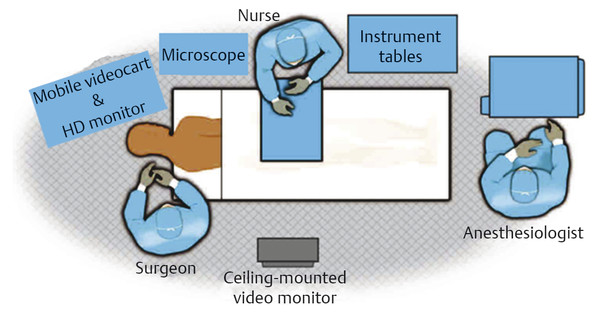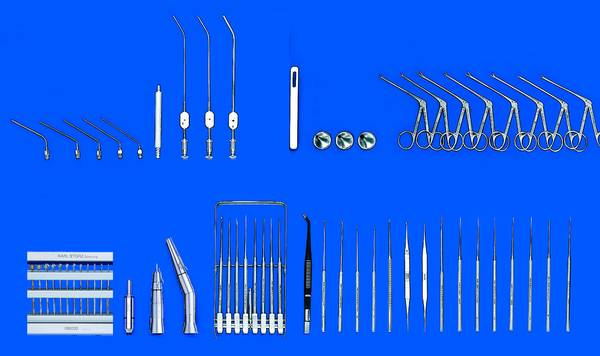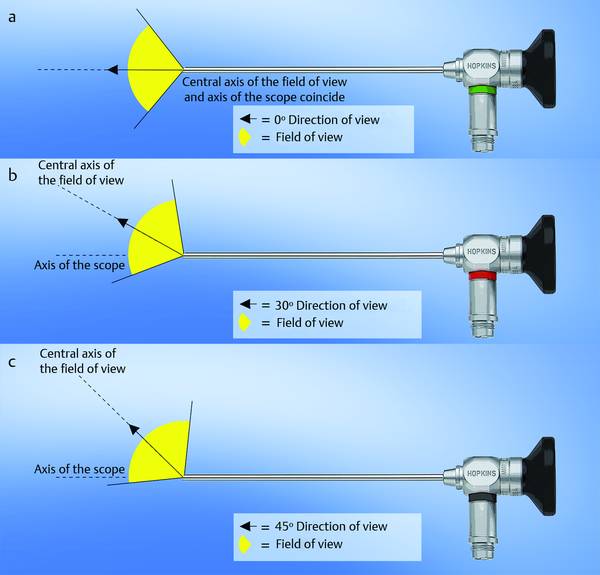Introduction
This chapter provides an in-depth description and state-of-the-art illustrations of the devices and instruments used for endoscopic ear surgery. New technologies have stimulated the creation of special endoscopic equipment and microinstruments specifically designed to fulfill the particular requirements of endoscopic ear surgery. This advance in instrumentation has in turn contributed to the progress of endoscopic ear surgery. These new specially designed instruments have widened the indications and refined the surgical skills, which in turn allows better control over the pathology and permits access to previously unreachable or difficult-to-reach anatomical recesses such as the sinus tympani, facial recess, and anterior epitympanic recess.
The operating room for ear surgery should incorporate state-of-the-art instrumentation. The surgeon should be in a comfortable working position during the prolonged holding of the endoscope mounted with the endoscopic video camera. A specially designed surgical chair, preferably with armrest, helps in providing adequate hand and back support.
A magnetically operated microscope is an essential part of the instrumentation. Such a microscope is also supplied with built-in high-definition (HD) camera or can be used with a detachable HD camera that will allow continuous documentation in parallel with the endoscopic surgery performed entirely through an HD video monitor. The availability of continuous video monitoring enables the anesthesiologist, the scrub nurse, and others to observe and follow the performance of the operation. Recordings can also be used for teaching purposes.
The scope of this chapter is to describe and discuss the instrumentation used in endoscopic ear surgery which includes the following:
Positioning and general equipment necessary for any operating room
Standard instruments for microscopic ear surgery
Special equipment and instruments for endoscopic ear surgery
Advanced new technologies used in otological surgery.
In addition, certain endoscopic neurotological procedures require very specific instrumentation and this will be considered later in ▶ Section 7.6.
7.2 Positioning and General Equipment
7.2.1 Operating Room Setup
The patient is placed supine on the operating room table in the normal otological position. The microscope is placed in the sterile field ready to be used alternately with the endoscope if required. The endoscopic tower is placed directly facing the surgeon, and the monitor is directly level with the surgeon’s eyes. Because the surgeon is not looking down into the eyepiece of the endoscope but rather directly forward at the video screen, proper alignment of these components is essential to preserve the surgeon’s orientation to the surgical field and to ensure a comfortable working position. In general, an OR incorporating multiple monitors and ceiling-mounted equipment provides an excellent environment for complicated and lengthy procedures (▶ Fig. 7.1).

Fig. 7.1 Diagram of the operating room (OR) setup and patient positioning, showing the position of the video monitor tower and microscope in relation to the patient and surgeon.
7.2.2 The Operating Microscope
The operating microscope is indispensable for most otological surgery as it combines visualization, connectivity, and data management all in a single suite. It should be available, sterile, and ready in the surgical field even when exclusively endoscopic ear surgery is intended. The operating microscope should provide both visualization and flexibility. It should be integrated with an HD camera connected to an HD medical monitor to allow the best visualization. The ergonomic handgrip design and friction-free electromagnetic clutches provide tremendous flexibility in the operating room, allowing easy alternation between microscope and endoscope throughout the surgical procedure.
7.2.3 The Contraves Table
The Contraves table allows ideal positioning and rotation of the patient without changing the microscope’s or the surgeon’s position when alternating between endoscope and microscope. The patient and operating room table, equipment, and personnel are shown in ▶ Fig. 7.1.
7.3 Standard Instruments for Microscopic Ear Surgery
Besides the standard instruments required for the approach work through the soft tissue (scalpels, forceps, mono- and bipolar diathermy, etc.) an otological instrument set (▶ Fig. 7.2) of special interest includes:

Fig. 7.2 Standard otological instrument set used by otologists in all regular microscopic ear surgery. A selection from a Plester basic set for ear microsurgery (Karl Storz GmbH & Co. KG, Tuttlingen, Germany).
Self-retaining mastoid retractors
Instruments for bone work: microdrill, micromotor handles straight and curved; set of different-sized tungsten cutting burs and diamond burs
Irrigation and suction instruments
Soft tissue dissectors, large and small scissors, toothed and nontoothed forceps, periosteal raspatory.
In general, a full set of microsurgical instruments is required, and these are very familiar to the practicing otologist:
Microforceps (microcup and microalligator); microscissors delicate, straight and curved; microhooks of different angles and lengths, needles; elevators, knives of different sizes and shapes, e.g., round cutting knife, Plester vertical cutting knife, and sickle knives of variable curvatures; Rosen elevator; House curette, large and small size; etc.
Suckers and suction-irrigation of different sizes
Fine suction tips and adaptors with control hole.
7.4 Endoscopes and Special Instruments for Endoscopic Ear Surgery
7.4.1 Ear Endoscopes
Endoscopes have demonstrated increasing benefit in ear surgery. Incorporation of the endoscope into the surgical armamentarium in otology has contributed greatly to the concept of minimally invasive surgery. This is because the operating microscope requires wide viewing portals for adequate illumination and visualization of the operative field, in contrast to the endoscope, which provides direct vision with illumination of the target field, thus avoiding the need for extra exposure and extra drilling.
Endoscopes have many proven advantages over the microscope, including wider angle of view, better visualization of structures that are parallel to the axis of the microscope, visualization of deep recesses and hidden structures (i.e., around corners), and the ability to visualize beyond the shaft of the surgical instrument. On the other hand, the disadvantages of endoscopes include loss of depth of perception and binocular vision, the inevitable one-handed surgical technique necessitated, the need for a strictly bloodless field (hence meticulous attention to hemostasis is essential), fogging and smearing of the tip of the endoscope, the mandatory requirement for reliable physician training, and the cost of the equipment.1–3
7.4.2 Rigid Endoscopes
The Hopkins rod lens system was developed to provide endoscopes of variable lengths, diameters, and angles of view. The rigid endoscopes commonly used for ear surgery are either 2.7 mm, 3 mm, or 4 mm in diameter. All the new endoscopes are now autoclavable. The working lengths are 18 cm, 15 cm, 14 cm, 11 cm, and 6 cm. The larger the diameter, the better the image is displayed and the more light it can transmit to the operative field. The 0° and 30° angled endoscopes are the most commonly used followed by the 45° endoscope. An endoscope with a greater angle, such as 70°, is difficult and disorienting to work with and is only used for inspection in restricted spaces such as the sinus tympani (ST), which lies very deep in 20% of cases (▶ Fig. 7.3, ▶ Fig. 7.4). More recent developments in the optics have led to the creation of new generation of wide-angled endoscopes with smaller diameters but providing better-quality images. Although there are endoscopes of several lengths and diameters, the authors suggest the use of endoscopes with 3 mm diameter and 15 cm length, with angles of 0° and 45°; only in the instance of a wide external auditory canal should a 4-mm endoscope be employed (▶ Fig. 7.5).

Fig. 7.3 a–c Diagram showing the field of vision of each type of endoscope. This demonstrates the need for modified angled instruments to be able to work around corners. Definitions—Direction of view: the angle between the mechanical axis and the center of the field of view. Field of view: the angle measured at the tip of the endoscope to two points at the extreme diameter of the viewed field. Depth of field: the distance between an object placed as close as possible to the distal tip of the endoscope while remaining in focus (i.e., near-object distance) and an object placed as far as possible from the distal tip of the endoscope while remaining in focus (i.e., far object distance). This picture shows the three endoscopes (0°, 30° and 45°) most commonly used during ear surgery, whether exclusively endoscopic or along with use of the microscope.

Fig. 7.4 a–c Schematic drawing of the sinus tympani (ST) and pyramidal eminence area showing the field of view of endoscopes of different angles. This illustrates the degree of visualization that each endoscope can provide.

Fig. 7.5 Karl Storz Hopkins endoscopes of length 15 cm , diameter 4 mm, with different angles of 0° and 45°.
The 0° endoscope provides all the imaging needed to perform major steps of any endoscopic operation. Its optics allow near-complete exposure of most of the field and the pathology. However, the extent of visualization with the 0° endoscope is limited by its optical capabilities. The distal lens of the otoscope must be cleaned with an antifog solution before each use.
Practically, in cholesteatoma surgery, once cholesteatoma resection under the 0° endoscope is deemed complete, it is replaced with the angled 30° or 45° instruments. By advancing the angled endoscope and rotating it clockwise and counterclockwise around its longitudinal axis, all middle ear recesses can be visualized, and any hidden pathology can be detected and removed. Resection of cholesteatoma is considered complete only after a final survey with the angled endoscopes has been completed, confirming absence of pathology. A 70° endoscope may also be used in this examination; however, in most cases, the information obtained by the 30° and/or 45° lens is sufficient to identify any residual pathology.4–7
7.4.3 Instruments
Stay updated, free articles. Join our Telegram channel

Full access? Get Clinical Tree


